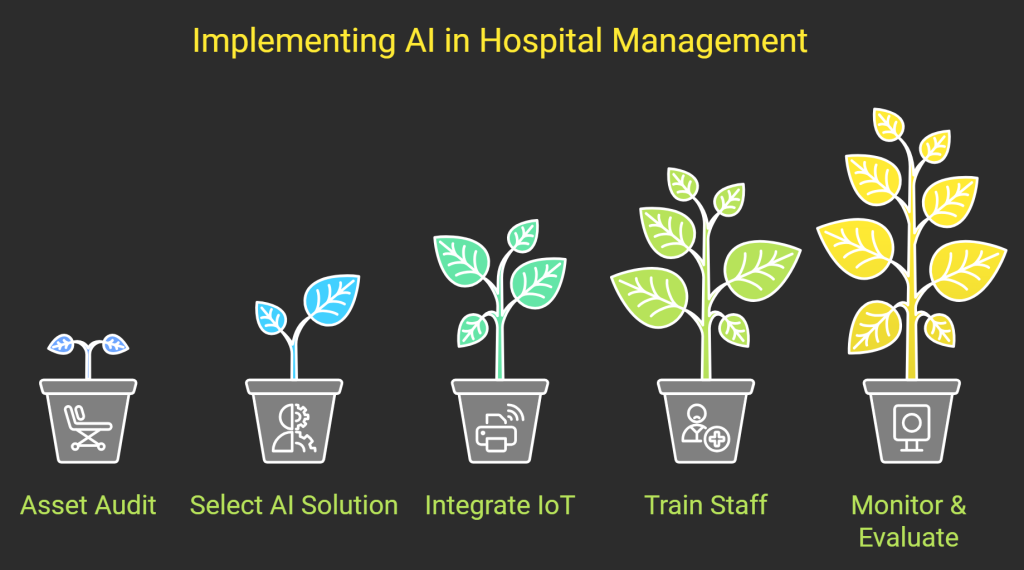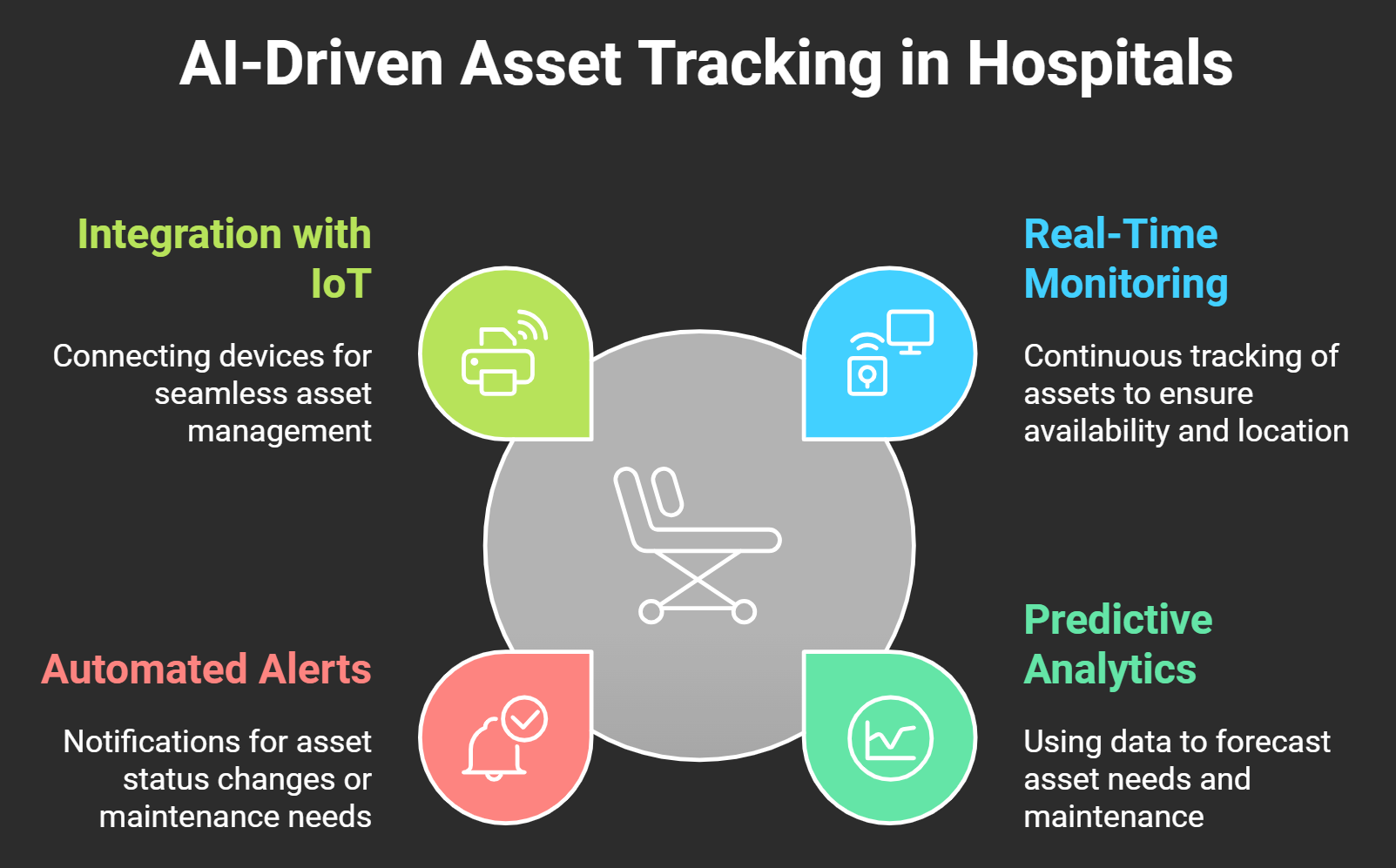Efficient management of hospital assets plays a critical role in ensuring seamless patient care and operational excellence. From medical equipment to surgical tools and hospital beds, asset tracking is a daunting task in large healthcare facilities. Traditionally, hospitals relied on manual methods that were often inefficient, leading to delays, mismanagement, and increased costs. However, with the introduction of AI technology, asset tracking and hospital equipment management have undergone a significant transformation.
By integrating solutions like AI, hospital management systems, and automation in healthcare, hospitals can optimize their workflows, minimize waste, and improve patient outcomes. This blog explores the detailed benefits of using AI for asset tracking and management in hospitals, with actionable insights on implementation and the role of emerging technologies like AI chatbots in healthcare.
How AI Transforms Asset Tracking and Hospital Equipment Management
AI technology enables hospitals to track and manage their assets with unprecedented efficiency. By providing real-time visibility, predictive maintenance, and automation capabilities, AI systems address long-standing challenges in hospital operations.
According to MarketsandMarkets, the global healthcare asset management market is expected to grow to $35.2 billion by 2027, driven by increasing adoption of AI-powered solutions. Hospitals are now leveraging advanced technologies to manage resources effectively, improve care delivery, and reduce operational expenses.
Benefits of AI for Asset Tracking and Management in Hospitals
1. Real-Time Asset Monitoring
One of the standout benefits of using AI for asset tracking is its ability to provide real-time visibility into the location and status of hospital equipment. With AI-driven tools, hospitals can monitor assets such as wheelchairs, infusion pumps, and ventilators in real time, ensuring their availability when needed most.
For example, AI-powered tools integrated into a hospital management system can alert staff about the nearest available medical devices, reducing the time spent searching for equipment during emergencies.
2. Predictive Maintenance
AI systems analyze historical data to predict when equipment requires maintenance. By identifying potential failures before they occur, predictive maintenance reduces downtime, extends the lifespan of assets, and ensures the availability of critical tools. This proactive approach prevents disruptions in patient care and minimizes costly repairs.
3. Inventory Optimization
Hospitals often face challenges in maintaining an optimal inventory of medical supplies and equipment. AI-driven systems use data analytics to forecast demand, ensuring that hospitals neither overstock nor run out of essential items. Inventory optimization through AI has been shown to reduce wastage by up to 20%, improving both cost efficiency and operational readiness.
4. Enhanced Patient Safety
Faulty or outdated equipment can jeopardize patient safety. AI ensures that hospital assets meet safety standards by automating compliance checks and flagging devices that require replacement or maintenance. This reduces the risk of medical errors and enhances overall patient outcomes.
5. Cost Savings Through Automation
AI-powered automation in healthcare reduces the reliance on manual processes, leading to significant cost savings. By automating tasks such as equipment tracking, inventory management, and maintenance scheduling, hospitals can allocate resources more effectively and focus on delivering quality care.
6. Seamless Integration with Hospital Management Systems
AI solutions are designed to integrate seamlessly with hospital management systems, creating a unified platform for asset tracking, patient data management, and operational workflows. This integration enhances communication and coordination between departments, ensuring smooth operations.
The Role of AI Chatbots in Healthcare Asset Management
AI chatbots in healthcare have expanded beyond patient interaction to play a crucial role in operational efficiency. These intelligent assistants can provide instant answers to staff queries about asset locations, availability, and status. For example, a nurse could ask an AI chatbot, “Where is the nearest oxygen cylinder?” and receive a quick response, saving valuable time.
Additionally, AI chatbots help bridge communication gaps between departments, ensuring that inventory requests, maintenance alerts, and equipment status updates are processed efficiently.
Steps to Implement AI for Hospital Equipment Management

Implementing AI for asset tracking and hospital equipment management requires a strategic approach. Here’s a step-by-step guide to get started:
- Conduct a Comprehensive Asset Audit
Identify all the assets in your hospital, including medical devices, furniture, and supplies. Categorize them based on usage, criticality, and maintenance history. - Select the Right AI Solution
Choose AI tools that cater specifically to healthcare needs, such as real-time tracking, predictive maintenance, and inventory optimization. Ensure the solution integrates with your hospital management system. - Integrate IoT and AI
Equip hospital assets with IoT sensors that transmit real-time data to AI systems. This enables seamless tracking and monitoring. - Train Staff
Educate healthcare professionals on how to use AI systems effectively. Comprehensive training ensures smooth adoption and minimizes disruptions. - Monitor and Evaluate
Regularly assess the performance of AI systems and gather feedback from staff. Use this data to optimize workflows and enhance system capabilities.
Real-World Use Cases of AI in Hospital Asset Management
Improved Efficiency in Real-Time Tracking
A hospital in New York implemented an AI-powered asset tracking system and reported a 50% reduction in the time spent locating medical equipment. Staff members highlighted how the system improved their response times during emergencies.
Cost Reduction Through Inventory Optimization
In California, a mid-sized hospital used AI to optimize its inventory, resulting in a 20% cost reduction. By forecasting demand accurately, the hospital avoided overstocking and minimized wastage.
Enhanced Maintenance Planning
A healthcare facility in Texas adopted predictive maintenance tools powered by AI. The system reduced equipment downtime by 30%, saving the hospital approximately $500,000 annually.
The Future of AI in Hospital Equipment Management
As technology evolves, the role of AI in hospital asset tracking and management will continue to expand. Innovations like 5G connectivity, advanced IoT sensors, and edge computing will enhance the capabilities of AI systems, enabling faster and more accurate decision-making.
Moreover, the integration of AI with automation in healthcare will pave the way for smarter hospitals, where assets are managed seamlessly, costs are minimized, and patient outcomes are improved.
Conclusion
The adoption of AI for asset tracking and management is transforming hospital operations. From real-time monitoring to predictive maintenance and inventory optimization, AI solutions address critical challenges in managing hospital resources. By integrating these tools with hospital management systems and leveraging AI chatbots in healthcare, hospitals can achieve greater efficiency, cost savings, and patient satisfaction.
As the healthcare industry continues to embrace automation in healthcare, AI-powered solutions will play a pivotal role in shaping the future of asset management. Hospitals that invest in these technologies today will be better equipped to meet the demands of tomorrow.
FAQs About AI in Hospital Asset Tracking and Management
1. How does AI help manage and track hospital assets effectively?
AI enables real-time tracking, predictive maintenance, and inventory optimization, ensuring that hospital assets are available and well-maintained at all times.
2. What are the best AI tools for hospital equipment management?
Tools like IBM Watson IoT, GE Healthcare’s Asset Plus, and RFID-based AI systems are among the leading solutions for real-time hospital asset management.
3. How do AI chatbots in healthcare contribute to asset management?
AI chatbots assist staff by providing instant updates on asset locations and availability, streamlining workflows and reducing delays during critical moments.
4. What are the challenges of implementing AI for asset tracking in hospitals?
Challenges include high initial costs, integration with existing systems, and the need for staff training. However, these can be addressed through proper planning and phased implementation.
5. How does automation in healthcare improve operational efficiency?
Automation reduces manual errors, enhances coordination, and streamlines processes, allowing healthcare professionals to focus more on patient care instead of administrative tasks.

